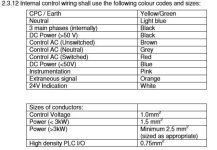theColonel26
Lifetime Supporting Member
We are creating a CE compliant version of one of our products, for sale in Ireland and the UK. We would like to use Brown for VDC+ and Blue for 0VDC. With 0VDC not being earth bonded. it seems that IEC Color code states that Brown and grey are to be used for non earth bonded system, and that Brown and Blue are to be used on a 0VDC earth bonded system.
If we use Brown and Blue for both are earth bonded and non-earth bonded is that going to cause an issue with being CE Compliant?
If we use Brown and Blue for both are earth bonded and non-earth bonded is that going to cause an issue with being CE Compliant?








